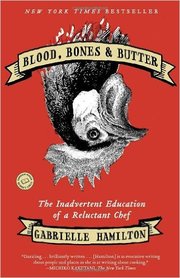
Blood, Bones & Butter: The Inadvertent Education of a Reluctant Chef by Gabrielle Hamilton, originally published in 2011 in hardback by Random House, now available in several formats. 2012 paper edition includes a “Reader’s Guide” that gives updates on what has happened in Hamilton’s life since the original publication. Available through Amazon and other outlets. She has also written a cookbook, Prune, with the recipes she serves in her restaurant of the same name. (“Prune” was her nickname as a child. She chose that name for her restaurant as a nod to her deep love for the food she grew up eating. Ho-kay, Gabrielle!
Well, where to begin? I guess you’d have to say that there’s no false modesty in an author who describes how, in one day, she opens up her relatively new restaurant for the day and discovers that a) someone has used her back step as a bathroom, and b) there’s a dead rat full of maggots on the retaining wall. Since she doesn’t want to ask the morning porter to clean up either mess, she does so herself. Later on that day she is a guest on the Martha Stewart TV show, picked up by a Lincoln town car, wafted to the studio and waited on by the “schlepper,” who tells her that he doesn’t know how she stays so humble. “Oh,” she says, “that’s not a problem with this line of work.” She gets back to her restaurant barely in time for the start of dinner service, so while everyone wants to know how it went and what Martha was like, they all have to get to their stations to finish prep. Gabrielle goes into the kitchen and discovers that the sink is clogged up with “caul fat” that someone has carelessly left there, so she plunges her hands into the drain to clean it out. Sort of a depths-to heights-to depths saga, all in about 12 hours.
I have to admit that I checked this book out of the library quite some time ago and was so put off by some of the subject matter (not the aforementioned saga, but drug use, lesbianism, and larceny, to name the top three) that I stopped. At some point recently I ran across a mention of the restaurant and found the audiobook available on my library service; Hamilton reads it herself, and I listened to it compulsively for a couple of days as I carried out my own kitchen tasks in preparation for the reception Friday night for the Chorale concert. She is a wonderful writer and no slouch as a reader. Be advised that she is extremely fond of four-letter words. Just a-sayin’.
And my word, what a life this woman has led! You’ll find yourself wanting to strangle her parents, who divorced when Gabrielle was 11 and basically left her and her brother, the two youngest children, to fend for themselves. What would you do if you were that age and suddenly realized that you needed to get a job or you wouldn’t eat? The mother had decamped, the father had disappeared. So our heroine does what any skinny, left-on-her-own 11-year-old would do: she walks into town and applies for a job at the first restaurant she comes across, saying that she is 16. And that’s basically the start of her adult life.
Time would fail me to try to do any summarizing of what happens to her over the next four decades or so. Along the way she blows almost $100,000 in a year on drugs and marries an Italian doctor for no discernible reason except that he pursues her aggressively, mostly because he falls for her as she stands at Prune’s stove and thus reminds him of his mother and because . . . he needs a green card. She falls more for his family than for him; indeed, over their ten-year marriage the only part of the year when they really enjoy each other or connect much at all is the month of July, when they vacation in Italy, staying at the apartment in Rome and the summer villa owned by Michele’s mother, Alda. Over that same decade they have two sons, Gabrielle almost works herself to death, and the two of them live mostly apart. I know. Pretty weird. By the end of the book it’s clear that there’s a divorce looming, and the most painful part for Gabrielle is that she probably won’t see Alda again. She is never able to have more than halting conversations with her mother-in-law, but she loves her and cooks with her.
The true reasons to read this book are the author’s personality and her beautiful, honest writing. I don’t know how people remember scenes in their lives from decades past in such haunting detail. Maybe she’s just making up a lot of it; I don’t know. It all rings true, I have to say. That 30-seat restaurant in New York City, with its lines out the door and accolades in the New York Times, it’s all the product of that plucky little girl walking into town looking for a job. Whatever else you may say about her (and there’s plenty to say), she’s first of all a survivor. One thing you won’t find a molecule of in this book: whining. If at all possible, take in her story by way of the audiobook so that you’re hearing her authentic voice in both senses of the word.
Oh, and the title? It refers literally to the materials she works with as a chef, but also metaphorically to family (blood), foundations (learning how to be a chef, or “making your bones”), and the sweet stuff, the good parts of life, the butter. And the chicken’s severed head? Well, I assume it refers to the first animal she ever killed, a chicken, chopping its head off with a dull axe while her father kibitzed from a safe distance. Ah, childhood!